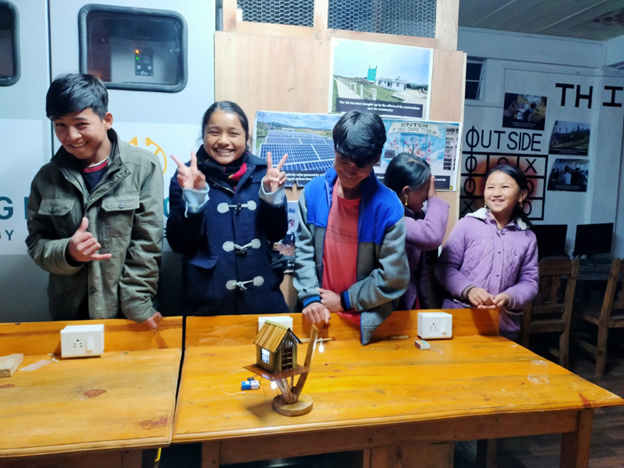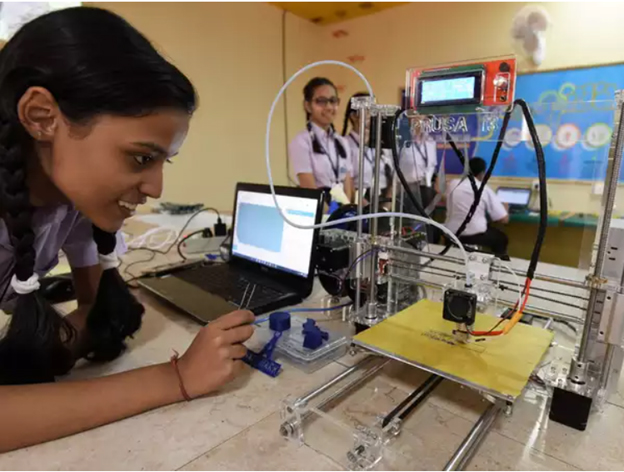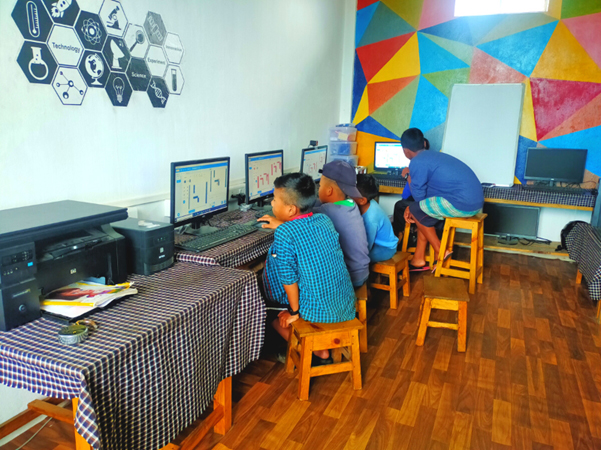Part 1 of 2
By: Anna Fitter for Smart Village Movement in Alliance with Berkeley Haas
Part 1 of 2
By: Anna Fitter for Smart Village Movement in Alliance with Berkeley Haas

Smart Village Movement – Salesforce Trailblazer Lab in Sohrarim Meghalaya
STEM: Going Beyond the Science Fair
STEM is a common acronym known for its focus on Science, Technology, Engineering, and Math is a relatively new term in the Indian education sector. In some circles, it’s referred to as STEAM, which incorporates ART to blend in creativity and design elements for a comprehensive learning experience.
STEM is a redefined learning approach where separate disciplines of Science, Technology, Engineering, and Mathematics are taught in cohesion. By definition, STEM is an interdisciplinary approach that uses the overlapping of disciplines to induce practicality in the study of all sciences and mathematics and engender an interest in engineering studies.
A well-designed STEM curriculum is an upgrade from a general curriculum. Instead of treating the disciplines in isolation, it combines them for parallel development of practical skills with theory. STEM classes generally involve limited theoretical instruction from an instructor/facilitator combined with hands-on problem solving and group projects using the concepts learned. An ideal STEM learning environment is all about asking questions and encouraging independent thinking. In STEM, failure teaches students to problem-solve and is an essential part of growth.

Learners with their emergency light project as a part of Curiosity Gym’s Innovation Hub concept at our rural Trailblazer Lab in Sohrarim, Meghalaya

Kids learning through Computers in Salesforce Trailblazer lab, Sohrarim
Why does India Need to Integrate STEM Education in Classrooms?
A robust STEM education builds critical thinkers, problem-solvers, team players, and next-generation innovators. India is one of the countries that produce the highest number of scientists and engineers at approximately 1,50,000 graduates per year, yet, the link between higher education in engineering or technology and entrepreneurship in that space is limited in India.
Worldwide, Indian engineers and scientists dominate talent and sheer employee numbers , especially in Silicon Valley tech firms. However, despite top-quality talent, the theoretical education model of our imperial past with an unbalanced focus on exams and tests has limited these students in innovation, problem-solving, and hands-on creativity. This is one of the reasons radically fewer Indian graduates go on to be entrepreneurs and innovators in the STEM field on a national or global stage. A healthy STEM ecosystem from early grades can help bridge the gap. Now, with the Government of India also focused on campaigns such as the ‘Make in India’ Innovation Mission, there is a focus on developing innovation and manufacturing right from the school years.
With a worldwide trend toward automation, Artificial Intelligence (AI), and digital technology, STEM jobs are growing faster than the number of STEM graduates. Our need for future generations educated in sciences and well-versed in digital technology has significantly boosted our interest in STEM in recent years.

Curiosity Gym’s Innovation Hub helps build STEM knowledge among learners through hands-on practical projects like this “Light House” on display
Benefits of a Robust STEM EDUCATION:

Young boy learning from online classes
Picture Source: Unsplash
Global Policy Upgrade
Incorporating STEM education in classrooms is now encouraged via policy measures by national governments. It is also supported and encouraged by corporations that invest a considerable chunk of their research budgets and CSR funds in agencies that promote it. Several organizations and think tanks, especially in North America, Europe, and Southeast Asia, have committed funding and resources to develop the STEM approach globally and supporting emerging markets like India to bring STEM to previously underserved student communities in rural areas.
In the age of smart classrooms, instructors can help students understand concepts more clearly by assimilating audio-visual information and using digital tools, gamification, and project-based learning.
India Rises to the Challenge
India is still in the early stages of this multidisciplinary approach. Still, much innovation is taking place concerning STEM education, especially in progressive urban schools. Smart Village Movement also seeks to bring these opportunities to rural communities.
Some new developments:

A student with 3D Printer in Atal Tinkering Lab
Picture Source

Honorable Prime Minister Narendra Modi with young innovators
Picture Source
How is this Benefitting Rural Classrooms in Underserved Communities?
Smart Village Movement’s Rural Grand Challenge to Incorporate STEM in Rural Schools: One of the biggest challenges in implementing STEM education is to design infrastructure and curriculum and equip children with the best guidance and support. In North East India especially, there is a remarkably lower uptake of STEM careers and higher education in STEM fields than the National Averages for several reasons.
Overcoming Challenges in STEM Implementation in Rural Areas
In remote, geographically challenging, and sparsely populated states, private Edtech companies don’t find rural areas a viable market yet. That is where non-profit education organizations, Government support, and funding come in to help build social capital. Organizations like SVM facilitate pilot projects in Education by bringing in companies and helping them build a sustainable business model for the rural context with our knowledge partner UC Berkeley-Haas
Investing in educating the ecosystem about the need for such programs is one of the ways of overcoming these limitations.
SMART VILLAGE MOVEMENT SOLUTION:
We envision a future where quality education is made available to every child in the country.
Inspiring Children: We aim to enable and inspire all children to participate in the digital world, with a particular focus on girls and those from disadvantaged groups
Increased Access to Effective Learning: Provide access to maker spaces and learning tools for village students to quickly and effectively learn digital skills and creativity.
Open Innovation: We collaborate with Educators, Government Agencies, and Companies to facilitate and curate an exceptional learning ecosystem with modern curriculum materials, training programmes, and resources.
Support Communities of Educators and Partners: We build and support communities of educators and partners to remove the barriers to learning digital skills in underserved rural communities where no such opportunities existed before : Eg: Salesforce Trailblazer Labs, Curiosity Gym Innovation Hubs. Nav Gurukul software training programme for girls, Meraki Python Course, and IBM coding classes.

Smart Village Movement – Salesforce Trailblazer Lab in Sohrarim Meghalaya

Online Programming residential course for girls by Navgurukul
Picture Source
Conclusion: STEM education is the need of the hour to help students make the leap from technology users to innovators. India needs combined support from the government and other education organizations to explore the opportunity and benefits of STEM education. We can do this together by rising to the challenge and developing a culture of application-based learning and innovation in schools and universities.
Stay tuned for Part 2 of this Blog, where we discuss the tools and resources available globally to incorporate STEM education at age-appropriate stages in school and the community. Part 2 will also showcase the various pilot projects and initiatives undertaken by Smart Village Movement in Meghalaya in North East India.

An Engineer working on a laptop
Picture Source: Unsplash
ABOUT SMART VILLAGE MOVEMENT: The Smart Village Movement is a collaborative process facilitated by the SVM organization with the Berkeley-Haas Center of Growth Markets to create a Smart Village ecosystem. We partner with Government, Academia, Corporations, and Rural Communities to foster independence and sustainable rural development in Indian villages and other emerging markets. Our mission is to empower rural people through digital technologies and open innovation platforms to access global markets.

Online Learning Platforms
Picture Credit: Unsplash
Our focus on Open-innovation, indigenous technologies, and natural economic forces build a well-developed SVM ecosystem that empowers rural communities to provide for themselves through entrepreneurship, job skills, and access to global markets.
Visit our website to learn more: https://www.smartvillagemovement.org/
Visit our Open-Innovation Platform: https://platform.smartvillagemovement.org/home
Subscribe to our Newsletter for monthly updates and more articles like this: https://www.smartvillagemovement.org/newsletter/